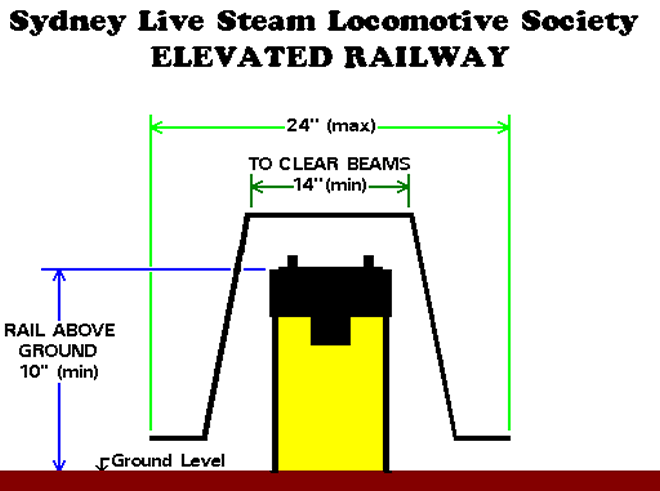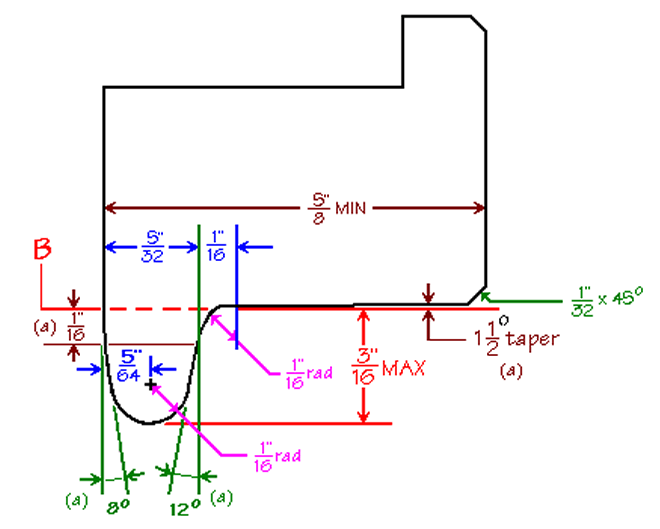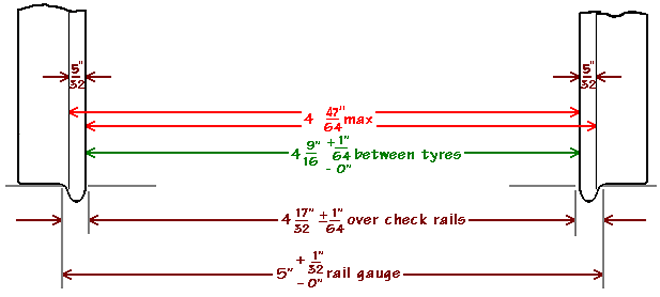Wheel, Track, and Signalling Standards
About our Wheel and Track Standards
The SLSLS wheel standards were published in July 1966 to provide a basis for engineering a sound miniature railway system. Correct dimensioning of point flangeways and checkrails to match wheel profiles is essential for a derailment free railway. The SLSLS system is designed from the ground up and does not scale full size. The concept is that we need to engineer a miniature railway and while the principles are important, scale sizing does not follow them. Our standards are based on the use of steel bar rail of 25mm by 10mm section. (Previous sections were 7/8" by 3/8"). The wheel width is wider than the rail width to the extent that the face of the wheel does not come over the rail head when the opposite wheel is hard up with the flange against the rail. This ensures that oil on the wheel face (from coupling rod oiling, etc) is not deposited on the rail top. The flange is also beefed up for greater strength. This permits the flanges on intermediate driving wheels to be thinner without significant loss of strength.
Track is constructed to 5 1/32 " gauge as a standard with gauge widening on the sharp curves. For a 30 ft radius curve the gauge is made 5 1/16 ". This has successfully accommodated all vehicles to date. The Society also recommends building to 1 1/8" to the foot scale. This has the advantage of being 3/32" to the inch for a standard gauge (4' 8 1/2"model) which is relatively easy to work to. It also has the advantage of producing a slightly larger model. The extra width is from the outside of the frames over the cylinders and permits use of more generous bearings and greater clearance with valve gear components, connecting rods and crank pins.
The SLSLS wheel standards have been adopted as the Australian Association of Live Steamers 5 inch gauge standards, and there is a growing number that build to these standards.
Table of Contents
- Clearance of running gear above rail head under full load to be not less than 0.375 inches; (car running boards 0.625 inches).
- For intermediate driving wheels where flanges are not required the tread diameter shall be machined parallel for the total width of flange and flange to tread radius. viz 5/32"+1/16"= 7/32".
- For intermediate driving wheels where thin flanges are required the flange width shall be 1/8". The reduction of 1/32" to be effected from the front of the flange.
SLSLS Elevated Track Standards

SLSLS Signal Indications
The ground level railway SLSLS signal indications are based on the NSWGR single light colour light indications. Our difference is that we do not install the marker light on either the main line signals or shunt signals.
The elevated track signals are full size NSWGR signals. Both lower quadrant and banner style signals are in use.
Colour Light Signals
| Indication | Colour / Form | Meaning |
|---|---|---|
| Stop | Red | Stop |
| Caution | Yellow | Next signal at stop |
| Medium | Pulsating Yellow | Next signal not at stop |
| Clear | Green | Proceed |
| Caution Turnout | Yellow Band of Lights | Proceed through turnout to the left. Next signal at stop. |
| Medium Turnout | Pulsating Yellow Band of Lights | Proceed through turnout to the left. Next signal not at stop. |
Subsidiary Colour Light Shunting Signals
| Indication | Colour / Form | Meaning |
|---|---|---|
| Shunt (Bracketed to left on main signal post) | Yellow | Proceed through turnout to the left, being prepared to stop short of any obstruction. |
Shunting Signals
| Indication | Colour / Form | Meaning |
|---|---|---|
| Shunt | Yellow | Proceed but be prepared to stop short of any obstruction. |
| Wrong Road Shunt | Yellow | Proceed in the wrong running direction, being prepared to stop short of any obstruction. |
Indicators
| Indication | Colour / Form | Meaning |
|---|---|---|
| Guards Indicator | White | Signal at the end of the platform is cleared. |
Banner Signals
| Indication | Colour / Form | Meaning |
|---|---|---|
| Stop | Horizontal Arm | Stop |
| Caution | Horizontal Fish Tailed Arm | Next signal at stop |
| Clear | Inclined Arm, or Inclined Fish Tailed Arm | Proceed |
Banner Shunting Signals
| Indication | Colour / Form | Meaning |
|---|---|---|
| Stop | Horizontal Arm | Stop |
| Shunt | Inclined Arm | Proceed but be prepared to stop short of any obstruction. |
| Wrong Road Shunt | Inclined Arm Skeletel type | Proceed in the wrong running direction, being prepared to stop short of any obstruction |



